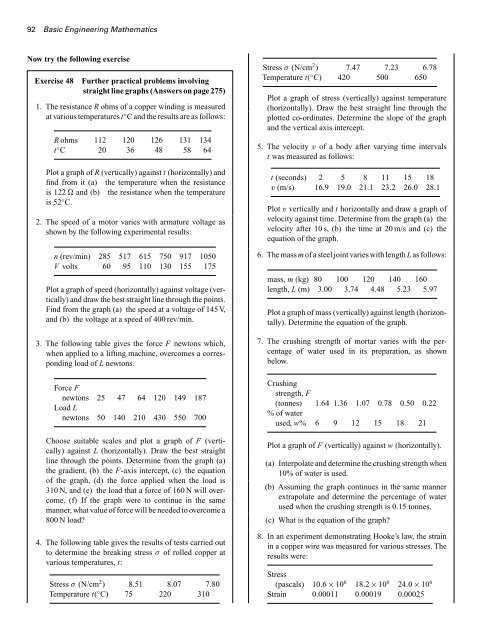basic_engineering_mathematics0
Create successful ePaper yourself
Turn your PDF publications into a flip-book with our unique Google optimized e-Paper software.
92 Basic Engineering Mathematics<br />
Now try the following exercise<br />
Exercise 48<br />
Further practical problems involving<br />
straight line graphs (Answers on page 275)<br />
1. The resistance R ohms of a copper winding is measured<br />
at various temperatures t ◦ C and the results are as follows:<br />
R ohms 112 120 126 131 134<br />
t ◦ C 20 36 48 58 64<br />
Plot a graph of R (vertically) against t (horizontally) and<br />
find from it (a) the temperature when the resistance<br />
is 122 and (b) the resistance when the temperature<br />
is 52 ◦ C.<br />
2. The speed of a motor varies with armature voltage as<br />
shown by the following experimental results:<br />
n (rev/min) 285 517 615 750 917 1050<br />
V volts 60 95 110 130 155 175<br />
Plot a graph of speed (horizontally) against voltage (vertically)<br />
and draw the best straight line through the points.<br />
Find from the graph (a) the speed at a voltage of 145V,<br />
and (b) the voltage at a speed of 400 rev/min.<br />
3. The following table gives the force F newtons which,<br />
when applied to a lifting machine, overcomes a corresponding<br />
load of L newtons.<br />
Force F<br />
newtons 25 47 64 120 149 187<br />
Load L<br />
newtons 50 140 210 430 550 700<br />
Choose suitable scales and plot a graph of F (vertically)<br />
against L (horizontally). Draw the best straight<br />
line through the points. Determine from the graph (a)<br />
the gradient, (b) the F-axis intercept, (c) the equation<br />
of the graph, (d) the force applied when the load is<br />
310 N, and (e) the load that a force of 160 N will overcome.<br />
(f) If the graph were to continue in the same<br />
manner, what value of force will be needed to overcome a<br />
800 N load?<br />
4. The following table gives the results of tests carried out<br />
to determine the breaking stress σ of rolled copper at<br />
various temperatures, t:<br />
Stress σ (N/cm 2 ) 8.51 8.07 7.80<br />
Temperature t( ◦ C) 75 220 310<br />
Stress σ (N/cm 2 ) 7.47 7.23 6.78<br />
Temperature t( ◦ C) 420 500 650<br />
Plot a graph of stress (vertically) against temperature<br />
(horizontally). Draw the best straight line through the<br />
plotted co-ordinates. Determine the slope of the graph<br />
and the vertical axis intercept.<br />
5. The velocity v of a body after varying time intervals<br />
t was measured as follows:<br />
t (seconds) 2 5 8 11 15 18<br />
v (m/s) 16.9 19.0 21.1 23.2 26.0 28.1<br />
Plot v vertically and t horizontally and draw a graph of<br />
velocity against time. Determine from the graph (a) the<br />
velocity after 10 s, (b) the time at 20 m/s and (c) the<br />
equation of the graph.<br />
6. The mass m of a steel joint varies with length L as follows:<br />
mass, m (kg) 80 100 120 140 160<br />
length, L (m) 3.00 3.74 4.48 5.23 5.97<br />
Plot a graph of mass (vertically) against length (horizontally).<br />
Determine the equation of the graph.<br />
7. The crushing strength of mortar varies with the percentage<br />
of water used in its preparation, as shown<br />
below.<br />
Crushing<br />
strength, F<br />
(tonnes) 1.64 1.36 1.07 0.78 0.50 0.22<br />
% of water<br />
used, w% 6 9 12 15 18 21<br />
Plot a graph of F (vertically) against w (horizontally).<br />
(a) Interpolate and determine the crushing strength when<br />
10% of water is used.<br />
(b) Assuming the graph continues in the same manner<br />
extrapolate and determine the percentage of water<br />
used when the crushing strength is 0.15 tonnes.<br />
(c) What is the equation of the graph?<br />
8. In an experiment demonstrating Hooke’s law, the strain<br />
in a copper wire was measured for various stresses. The<br />
results were:<br />
Stress<br />
(pascals) 10.6 × 10 6 18.2 × 10 6 24.0 × 10 6<br />
Strain 0.00011 0.00019 0.00025















![[Lonely Planet] Sri Lanka](https://img.yumpu.com/59845622/1/169x260/lonely-planet-sri-lanka.jpg?quality=85)

